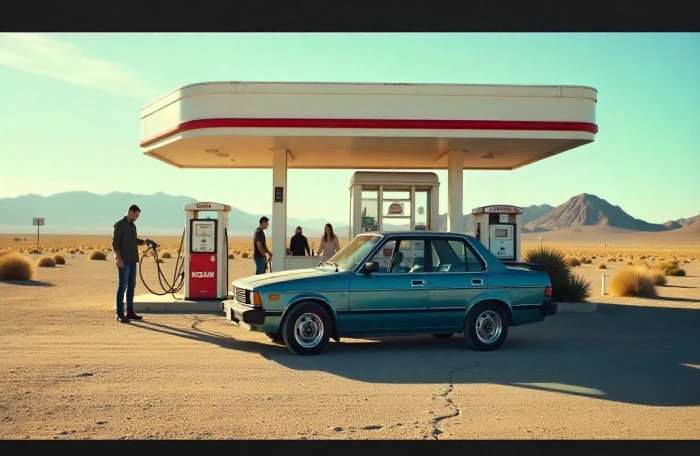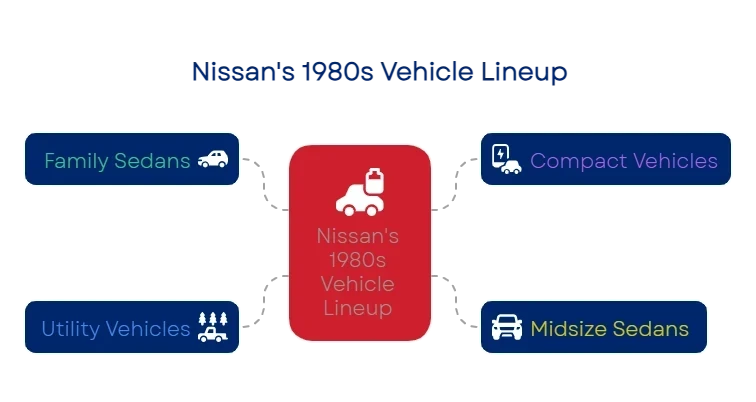Nissan cars played a key role in building the brand’s global reputation for reliability, performance, and bold design. During the 1980s, the brand transitioned from its Datsun identity to strengthen its global image for reliability, performance, and bold design. Focused on the North American market, the brand aimed to offer more than basic transportation by introducing technology and styling to rival competitors like Toyota.
By 1984, the shift to the Nissan name was complete, reflecting a broader global strategy to unify its presence and boost credibility with buyers and analysts. Many of the most notable models released during this time are still appreciated today by collectors and car enthusiasts. Some, like the Nissan 300ZX and Nissan Silvia, are now recognized in the U.S. and Japan as early examples of affordable performance cars. Others, such as the Nissan Stanza and Sentra, helped families get where they needed to go without giving up fuel economy or reliability.
Whether you're looking into how Nissan’s design language evolved, why certain Z cars became icons, or how market strategies shaped its lineup, this article will give you a clear look at the decade that helped define the modern Nissan brand.
Nissan’s Rebrand and Engineering Focus in the 1980s
In the early 1980s, Nissan made a bold shift. The company replaced the Datsun name on its U.S. models with the Nissan badge. This change wasn’t only about branding; it marked a new phase in how Nissan wanted to be seen around the world.
The process began in 1981 and wrapped up by 1984.
Nissan spent about $30 million updating dealerships, ads, and materials to reflect the change.
The goal was to remove confusion between the company name and the brand names it used in different regions.
For long-time Datsun owners, the change felt unfamiliar at first. But for Nissan, it made things simpler and helped the company grow a stronger identity in the U.S., Europe, and other markets.
While the name was changing, so were the cars.
Nissan engineers focused on building vehicles that didn’t just get you from point A to point B. They wanted cars that were fun to drive, efficient, and built to last. During this time, Nissan introduced:
Sleeker, more aerodynamic styling
Turbocharged engines and performance upgrades
Digital dashboards and other forward-looking tech
A mix of sporty models and practical cars for everyday use
This period helped shape the modern Nissan brand. Many of the design ideas and engineering choices from the 1980s continued into the next decade, and some still show up in today’s models.
What You'll Learn
Which Nissan models stood out in the 1980s
How Nissan transitioned from Datsun to Nissan
Why some 1980s Nissan cars are gaining value today
Overview
This article explores the significant role of 1980s Nissan cars in shaping the brand's identity and global reputation, focusing on the era's design, performance, and strategic changes, with relevance varying depending on individual interests in automotive history, design trends, or vehicle collection.
Here's a more detailed breakdown:
Standout Sports Models of the 1980s
These models, such as the Nissan 300ZX and Silvia, positioned Nissan as a contender in the sports car market with a blend of performance, innovation, and style that are still valued by collectors.
Everyday Models With Lasting Value
Nissan's practical models like the Stanza, Sentra, and Maxima offered reliability, fuel efficiency, and smart engineering, contributing to the brand's reputation and customer base expansion.
Unique or Niche Offerings
Less common vehicles like the Nissan Van and 720 Pickup served specific market needs or regions, playing important roles in Nissan's development and direction.
Concept Cars and International Variants
Rare or region-specific models, such as the Nissan Skyline and Fairlady Z, showcase Nissan's design and engineering experiments and are highly sought after by collectors.
Other Notable Aspects
Nissan's Rebranding
The transition from Datsun to Nissan in the U.S. market marked a strategic effort to unify the brand's global presence and strengthen its identity.
Standout Sports Models of the 1980s
The 1980s helped position Nissan as a serious contender in the sports car market. The company introduced models that delivered a mix of performance, innovation, and style. These weren’t show-only builds. They were production cars that gave buyers a real driving experience without sacrificing practicality.
Nissan 300ZX (Z31)
The 1984 Nissan 300ZX replaced the 280ZX and was the first Z car fully produced in the United States. It played a central role in strengthening the modern Nissan brand.
Key specs:
Engine: 3.0L V6, naturally aspirated (VG30E) or turbocharged (VG30ET)
Power: 160 hp (NA), 200 hp (turbo)
Transmission: 5-speed manual or 4-speed automatic
0–60 mph: 7.1 seconds (turbo)
Drivetrain: Rear-wheel drive
Notable features: T-tops, digital dashboard, independent rear suspension
This model helped Nissan gain ground in North America and remains one of the most popular Z cars among collectors.
Nissan Silvia (S12 / 200SX)
Sold in America as the 200SX, the Nissan Silvia (S12) brought lightweight performance and rear-wheel drive to a broader market. It later gained a following in drifting circles.
Key specs:
Engine: 1.8L I4 turbo (CA18ET), 2.0L I4 (CA20E), or 3.0L V6 (VG30E in select models)
Power: 102–145 hp depending on trim and market
Transmission: 5-speed manual or 4-speed automatic
Body styles: Coupe and hatchback
Drivetrain: Rear-wheel drive
Though not as famous as the 300ZX, the Silvia offered fun, mod-friendly performance in a smaller package.
Sentra SE
While not a full sports car, the Sentra SE of the late 1980s set the stage for the high-revving SE-R of the 1990s. It brought manual driving fun and strong fuel economy to a compact segment.
Key specs:
Engine: 1.6L or 1.8L 4-cylinder, depending on trim
Power: Approx. 90–110 hp
Transmission: 5-speed manual or 3-speed automatic
Notable traits: Lightweight body, responsive handling
These early trims showed that Nissan vehicles could offer engaging performance even outside of the Z car line.
Why These Cars Mattered
Nissan’s sports cars from this decade helped shift how buyers viewed the brand. They were affordable, stylish, and often ahead of their time in tech and handling. These models gave Nissan a real foothold in the global sports car market. Today, they still draw attention from car enthusiasts around the world and hold value for their role in Nissan’s history.
Everyday Models With Lasting Value
While Nissan’s sports cars grabbed attention in the 1980s, many of its everyday models helped the company grow its customer base and reputation. These cars were known for reliability, fuel efficiency, and smart engineering. They also played a key role in helping Nissan sell more vehicles across North America and other markets.
Nissan Stanza
The Nissan Stanza became one of the most recognized family sedans in the company’s 1980s lineup. It was practical, dependable, and easy to maintain. These traits made it a favorite among families and commuters.
Key specs:
Engine: 2.0L I4 (CA20E)
Power: 102 hp
Transmission: 5-speed manual or 4-speed automatic
Drivetrain: Front-wheel drive
Body styles: Sedan and hatchback
The Stanza helped introduce a new level of comfort and ride quality in compact sedans, especially in the U.S. market.
Nissan Sentra
The Sentra became one of the most important Nissan vehicles of the 1980s. It replaced the Datsun 210 and quickly became known for affordability and fuel economy.
Key specs:
Engine: 1.5L or 1.6L I4
Power: 70–90 hp depending on year
Transmission: 4- or 5-speed manual, or 3-speed automatic
Drivetrain: Front-wheel drive
Notable: One of the first cars in its class with optional fuel injection
The Sentra appealed to buyers looking for a reliable first car or a daily driver that cost less to run and maintain.
Nissan Maxima
By the mid-1980s, the Maxima had shifted into its role as a midsize sedan with performance leanings. Marketed as “The Four-Door Sports Car,” it offered more space than the Sentra or Stanza without giving up driver engagement.
Key specs:
Engine: 3.0L V6 (VG30E)
Power: 157–160 hp
Transmission: 5-speed manual or 4-speed automatic
Drivetrain: Front-wheel drive
Notable: Voice warning system, digital dash, and smooth V6 power
The Maxima’s blend of technology and performance made it one of the more unique offerings in a segment dominated by basic sedans.
Why These Models Mattered
These cars were built to meet the everyday needs of growing families, commuters, and cost-conscious buyers. These models weren’t flashy, but they worked. They helped expand Nissan’s reach in North America and strengthened trust in the Nissan name. Thanks to solid engineering and smart pricing, many of these cars stayed on the road long after their original sales date and their influence is still seen in current Nissan models like the Altima and Versa.
Unique or Niche Offerings
While models like the 300ZX and Sentra drew most of the attention, Nissan also released several lesser-known vehicles in the 1980s. Some were made for specific regions, while others filled gaps in the lineup. These Nissan models didn’t always lead the market in sales, but they played important roles in the brand’s development and direction.
Nissan Van (Vanette in Global Markets)
The Nissan Van arrived in the United States in 1986. It aimed to capture a piece of the growing compact van segment, which was popular among small businesses and families.
Key specs:
Engine: 2.4L inline-4 (Z24)
Power: 106 hp
Transmission: 5-speed manual or 3-speed automatic
Layout: Rear-wheel drive
U.S. production years: 1986 through 1990
Due to engine cooling issues, the van was eventually recalled in the U.S. Nissan discontinued it shortly after. However, the Vanette continued in other markets and helped set the stage for future compact utility vehicles in the Nissan lineup.
Nissan 720 Pickup
The 720 was Nissan’s compact truck offering before the Hardbody series took over in 1986. It was simple, efficient, and easy to work on, which made it popular in both rural and suburban settings.
Key specs:
Engine: 2.4L inline-4
Power: 103–106 hp
Transmission: 4- or 5-speed manual, or 3-speed automatic
Drivetrain: Rear-wheel or part-time four-wheel drive
U.S. production years: 1980 to 1986
It was also one of the first trucks Nissan manufactured in the U.S., which helped grow its presence in the light utility vehicle market.
Nissan Patrol (Global Model)
The Patrol was not sold in the United States during the 1980s. However, it remained one of the most recognized off-road vehicles in other parts of the world. In 1987, Nissan introduced the Y60 generation, which was widely used across Asia, the Middle East, and Australia.
Key specs (Y60):
Engine: 4.2L inline-six, naturally aspirated or turbocharged
Power: Up to 145 hp depending on version
Transmission: 5-speed manual or 4-speed automatic
Features: Full-frame chassis, part-time four-wheel drive, locking hubs
Though not a U.S. product, the Patrol helped shape the engineering behind later SUV models under the modern Nissan brand.
Nissan Bluebird
The Datsun Bluebird, later sold as the Nissan Bluebird, remained a key part of the company’s international offerings during the 1980s. While its presence in North America declined, it continued to sell well in Japan and parts of Europe.
Key traits:
Practical mid-size sedan platform
Known for fuel efficiency and smooth handling
Influenced future midsize vehicles, including early Nissan Altima designs
The Bluebird helped maintain Nissan’s competitive edge in overseas markets during a time of major change across the auto industry.
Why These Models Mattered
These vehicles added depth to Nissan’s lineup in the 1980s. Some were built for volume, while others explored specific needs in global regions. Whether it was the practicality of the 720 pickup or the off-road strength of the Patrol, each played a part in growing the company’s presence.
Nissan offered these models as part of a larger shift in product planning. That strategy helped support the company’s expansion into new segments and paved the way for models like the Nissan Kicks, Nissan Versa, and Nissan Leaf that are part of the current Nissan lineup today.
Concept Cars and International Variants
Some 1980s Nissan models didn’t make it to the U.S. or saw limited production. Others were early versions of what would become major global nameplates. For collectors and restorers, these rare or region-specific vehicles have become more appealing as the vintage car market grows. Many reflect key design or engineering ideas that shaped Nissan’s direction into the 1990s.
Nissan Skyline (R30 and R31)
Although the Skyline wasn’t sold in the U.S. during the 1980s, it became a defining model for Nissan in Japan. It served as the base for several racing and turbocharged platforms that helped shape the company’s performance identity.
Key traits:
R30 (1981–1985) and R31 (1985–1989) generations
Featured a mix of naturally aspirated and turbo inline-6 engines
Introduced early versions of Nissan’s multi-link rear suspension
Several high-performance versions were tuned for Group A racing
Skyline models from this era built the foundation for the GT-R’s return in 1989. They hold strong appeal among car enthusiasts worldwide today.
Nissan Fairlady Z (Japanese Domestic Market)
The Fairlady Z was the Japanese-market name for what U.S. buyers knew as the 280ZX and 300ZX. While similar, JDM versions often came with different trim levels, lighter curb weights, and additional tuning options.
Why collectors care:
Imported JDM Fairlady Zs are now legal under the 25-year import rule
Many came with desirable options not offered in North America
They offer an authentic link to Nissan’s history in Japan
Fairlady Z models are now regularly seen at auctions, meetups, and restoration shops across the U.S.
Regional and Concept Variants
Some vehicles developed in the 1980s served as test platforms or short-run market tests. While they weren’t all high-volume, they reflect Nissan’s expanding design focus and experimentation at the time.
Examples:
Nissan MID4: A mid-engine concept unveiled in 1985, meant to challenge sports cars like the Porsche 911. It never reached production, but its technology influenced the Nissan 300ZX and Skyline GT-R in later years.
Silvia Variants: In Japan, the Silvia was sold with several trim and engine packages unavailable elsewhere. This included factory turbo setups and lightweight tuning trims.
Limited-Run Bluebird and Leopard Models: These sedans, designed for domestic use, featured design details and powertrains later seen in early Infiniti vehicles.
While these vehicles weren’t always offered globally, they show how Nissan tested new styling, drivetrains, and layout ideas. For collectors, they represent early versions of what the modern Nissan brand would become.
Why These Models Are Gaining Value
Across the world, interest in vintage Nissan vehicles has grown steadily. Rising prices in the sports car market, increased visibility from enthusiast circles, and the availability of parts have made 1980s Nissan models more collectible.
Japanese imports, like the Fairlady Z and Skyline R30, are now legal to own and register in the U.S.
Concept cars like the MID4 are now seen as design milestones
Limited-run z cars and early performance sedans are in demand at auctions and restoration garages
Preserving these vehicles isn't just about nostalgia. It's about owning a piece of Nissan’s evolution, when the company was refining its style, performance goals, and engineering priorities. Many of these vehicles helped shape what would later become the Nissan Z, GT-R, and other icons in Nissan’s lineup.
Transport With Confidence Through AmeriFreight Auto Transport
If you’re buying, restoring, or maintaining a classic Nissan from the 1980s, AmeriFreight Auto Transport can help you protect it every step of the transportation. Learn more about transporting it safely with classic car shipping services, explore where to find classic cars online, or get an estimate and compare vehicle shipping options based on your vehicle and transport needs.
Frequently Asked Questions (FAQs)
What was Nissan called in the 80s?
Nissan was still selling cars under the Datsun name until it fully adopted the Nissan nameplate in the U.S. by 1984.
Which Nissan car was discontinued?
The Nissan Van was discontinued in the U.S. after a recall related to overheating and fire risks.
What cars did Nissan make in the 90s?
Nissan produced the 240SX, Maxima, Altima, Pathfinder, Sentra, 300ZX, and several global models in the 1990s.
What does Nissan mean in Japanese?
Nissan is short for “Nihon Sangyo,” which translates to “Japan Industries.”















